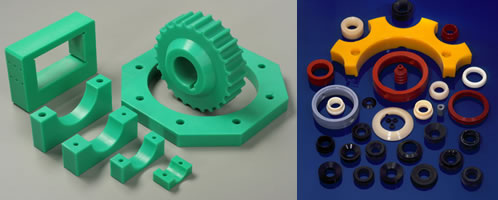Technical plastics consist of natural or synthetic polymers. Most often they are obtained from clean polymers such as polymethacrylate, polystyrene, polyethylene; copolymers or polymer mixtures. In addition to this, there are technical plastics obtained as a result of the modification of clean polymers. Polymers can be modified chemically (by means of hydrolysis), physicochemically (by means of degradation), or by addition of plasticisers, fillers, stabilizers and pigments.
The main source of classification of polymers is their reaction to the heat exposure. We distinguish between thermoplastic and thermo or chemo-hardening materials, the so called duroplasts.
When classifying polymers, the main component is often taken into consideration. Such classification distinguishes between plastics in which the main component is constituted by polyalkenes (polyethylene, polypropylene), polystyrene, vinyl resins poly(vinyl acetate), poly(vinyl alcohol), poly(vinyl chloride), poly(vinylidene chloride), fluoric polymers, acrylic resins, phenoplasts, aminoplasts, polyamides, polyurethanes, polyformaldehydes, cellulose derivatives such as acetylcellulose.
Sensitivity to heat exposure to over 100°C was the main disadvantage of most technical plastics. Polytetrafluoroethylene and silicones, which are resistant to up to 250°C, were invented during World War II. Further research followed and more technical plastics resistant to high temperature are commonly used: polysulphons invented in 1965, resistant to up to 200°C; polyphenyl sulfide invented in 1969, resistant to up to 170°C; and finally aromatic and organometallic polymers resistant to up to 400°C. Reduction of the combustibility of plastics is carried out by adding the so called antipyrines. Plastics are also characterised by capability of being moulded and coloured. That is why extrusion, plastic materials injection moulding, celendering and pressing are so commonly used.

Technical plastics have a wide usage in various branches of industry. They are used in the production of various machines, apparatus, electric cable sheaths, elements of chemical apparatus, household equipment, fancy goods, packaging, as well as in automotive, air, electrotechnical, electron, textile and building industries. Apart from that, plastics are used to producing equipment for medical purposes e.g. apparatus for blood collection and transfusion, drains, catheters, surgical threads; prosthesis e.g. dental, joint, vein, arterial, valve, eyeball; contact lenses etc.
Polymer is a Greek word standing for organic (rarely inorganic) macromolecular compound consisting of regularly or irregularly repeating units strung together through covalent chemical bonds. These units in turn, consist of monomers, which are typically small molecules of low molecular weight. The process of converting the units to a polymer is called polymerisation. The polymerisation degree is an average number of monomers in a polymer compound; compounds consisting of several monomers characterised by low molecular weight are called oligomers and compounds consisting of a large number of monomers characterised by high molecular weight are called multimolecular polymers. If a polymer compound contains monomers of one type (formed from one type of monomer), this polymer is called a homopolymer, and if a polymer compound is formed from more than one type of monomer, it is a copolymer. Polymer molecules can have different structure and shape; these features depend on the properties of the monomers used to synthesise them. We distinguish between polymers with linear molecules, branched-chain molecules and crosslinking molecules. Linear molecules (also called chain molecules) and branched-chain molecules (characterised by long chain branching) usually have thermoplastic properties: they melt during the heating process and they have capability of being moulded; that is why they are called thermoplastics, e.g. polystyrene and polyvinyl chloride. On the other hand, crosslinking molecules, which form a three-dimensional net, do not melt when exposed to high temperature (they do not become malleable); such polymers are obtained from multifunctional linear monomers or oligomers as a result of the reticulation carried out with the use of heating, chemical substances or ultraviolet radiation. Depending on the way in which they are obtained, polymers are called thermo hardening, chemo hardening or photopolymers such as phenyl-formaldehyde resin or polyester resins. Many polymers can be found in living organisms; they play an important role in the metabolism processes e.g. proteins, polysaccharides or nucleic acids, and some of them can be used for technical purposes e.g natural rubber. Nowadays, the production of synthetic polymers is predominant in plastic industries. Synthetic polymers are mainly processed into technical plastics, synthetic fibre, rubber, glue, and varnish. Polymers constitute a very important resource for modern industry; many of them are characterised by high mechanical endurance (equal to the mechanical endurance of steel), lightness (several times lighter than metals), chemical resistance and good thermoisolating and electroisolating properties. Polymers are very important in medicine, and recently they have been used in the field of environmental protection (cleaning water and air). Polyvinyl chloride is the most often used polymer in the technical plastic industry. Among the organic synthetic polymers there are polyethylene, polypropylene, polyamids, polyestrenes, phenoplasts, silicones and carbamide resisns. Inorganic polymers are also well known e.g. polyphosphates and polysilicates.
Moulding is one of the techniques of producing plastic elements. It is conducted in still moulds or in rotating moulds. We distinguish between several methods of moulding: rotational moulding in which technical plastic (liquid or powder) is poured into a heated, rotating quickly around one or two axes mould; pressure moulding in which plastic material is injected into a mould at 0,5-2 Mpa (plastic is suctioned into the mould); moulding matrix from a monomer or a partly polymerised substance (with the addition of catalysts and accelerators), whose polymerisation occurs in the mould and is called polymerising moulding. Technical plastics can also be moulded in the closed moulds, thanks to which empty products such as balls or dolls can be obtained. It is common knowledge that technical plastics are also used in the production of film. It is manufactured by moulding technical plastic solutions (cellulose derivatives), in which the solution is poured out through a narrow aperture of the heated container onto a belt conveyor or rotating barrel where the solvent evaporates. Apart from the mentioned above methods, dip moulding is also in use. This method involves dipping a form in an insulating plastic material and is used to inundate electronic and electrotechnical elements and systems.